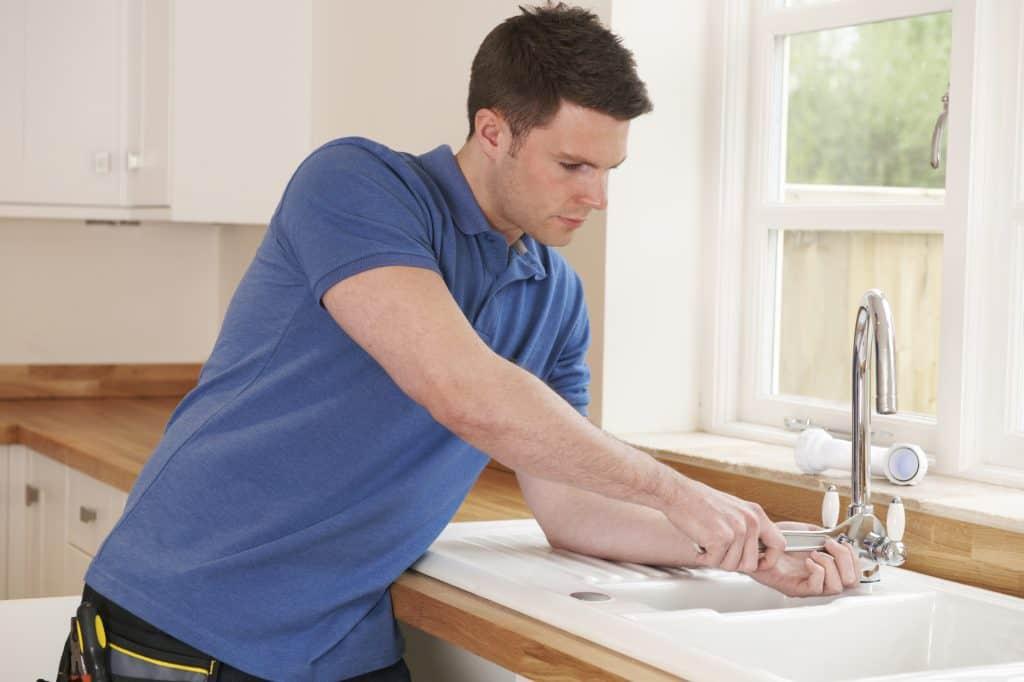A lot of people prefer resolving their plumbing issues by themselves. But fixing and installing kitchen faucets can be problematic, especially without the proper tools.
A basin wrench, also known as sink wrench, is a plumbing tool designed to make faucet removal and installation more efficient. It has a long shaft with a pair of asymmetric jaws at one end and a transversal handle on the other. These two jaws connect with a pivot pin.
You are watching: How To Remove Kitchen Faucet Without Basin Wrench
Not all homeowners have a basin wrench, though, because the tool is not that easy to use. Successfully loosening or tightening a faucet’s mounting nut with a sink wrench can take some practice.
In this article, we will help you learn an alternative method of removing a spout without using a complex basin wrench tool.
Things You Need To Prepare
If your kitchen faucet requires cleaning or fixing, you will need to prepare the appropriate cleaning tools.
If your faucet needs replacement, no additional tools are necessary. Just make sure that you have your new faucet replacement ready before you dismount the kitchen faucet.
If a basin wrench is not available at home, you might have socket wrench available in your toolbox. You will need a ratchet spanner, and you might need screwdrivers, channel lock pliers, a clean cloth, and water pump pliers as well. You may also use a sink drain wrench if you have one.
Read more : The 10 Best Chalk Paints of 2023 for Any DIY Project
To keep your kitchen from getting too messy, you will also need a towel or a cloth.
How To Remove Your Kitchen Faucet Without a Basin Wrench

Step #1: Turn Off Valves & Locate the Water Supply Lines
It is crucial to ensure that your hot and cold water line supplies are closed as a precautionary measure. You will find the water valves below the sink.
Turning off the water valves will block the water flow to your faucet. Completing this task will keep your kitchen from flooding while you work. Place a bucket beneath the sink to catch any remaining water that might come out.
Step #2: Open the Spigot
While there is no water flowing in the valve, it may still hold some air pressure inside. This leftover air pressure may be a problem for you.
Open the spigot and let the pressure bubble release for a few minutes. This task assures the tap will be lighter and more comfortable to remove after the pressure release.
Step #3: Disconnect the Water Piping
Water lines connect directly to the kitchen faucet. If you are fixing the faucet or installing a new one, you will need to cut off the water supply first.
Use the water pump pliers to detach the kitchen faucet from the water line. Although other improvised tools might work, it is recommended you use water pump pliers instead to help avoid damage.
Read more : Greatest Hits 2022: Single-Bowl Vs. Double-Bowl Sinks in the Kitchen
Gently fasten the water pump pliers to the water line and pull off each line with care. Besides using the right tools, you have to perform this step with caution. Otherwise, some parts might get damaged, including the faucet and the water line itself.
Step #4: Remove the Faucet Mounting Nuts or Screws
As soon as you have detached the faucet’s water line, the next thing to do is remove the faucet mounting nuts or screws. These nuts and screws are easy to identify since they hold the faucet together.
Loosen these faucet mounting nuts with a socket wrench. If the bolts are locked tightly, use some grease to try to unstiffen the nut joints. If your faucet has screws instead of nuts, use a screwdriver instead.
Step #5: Disconnect and Remove the Hose
Once you have finished removing the nuts and screws set them aside. It is now time to begin disconnecting the hose from the sink.
Clean the sink and the faucet. Inspect the faucet to see if it looks reusable. If it is in bad condition, such as corroded or cracked, purchase a new faucet to replace the old one.
After following the steps above, you can now reconnect your faucet.
Conclusion
Basin wrenches might be an efficient tool for fixing plumbing issues. But that does not mean there is no alternative tool to use if you do not have one.
Fix your faucet yourself by following these simple steps to remove your kitchen faucet without a basin wrench.
Source: https://gardencourte.com
Categories: Kitchens

